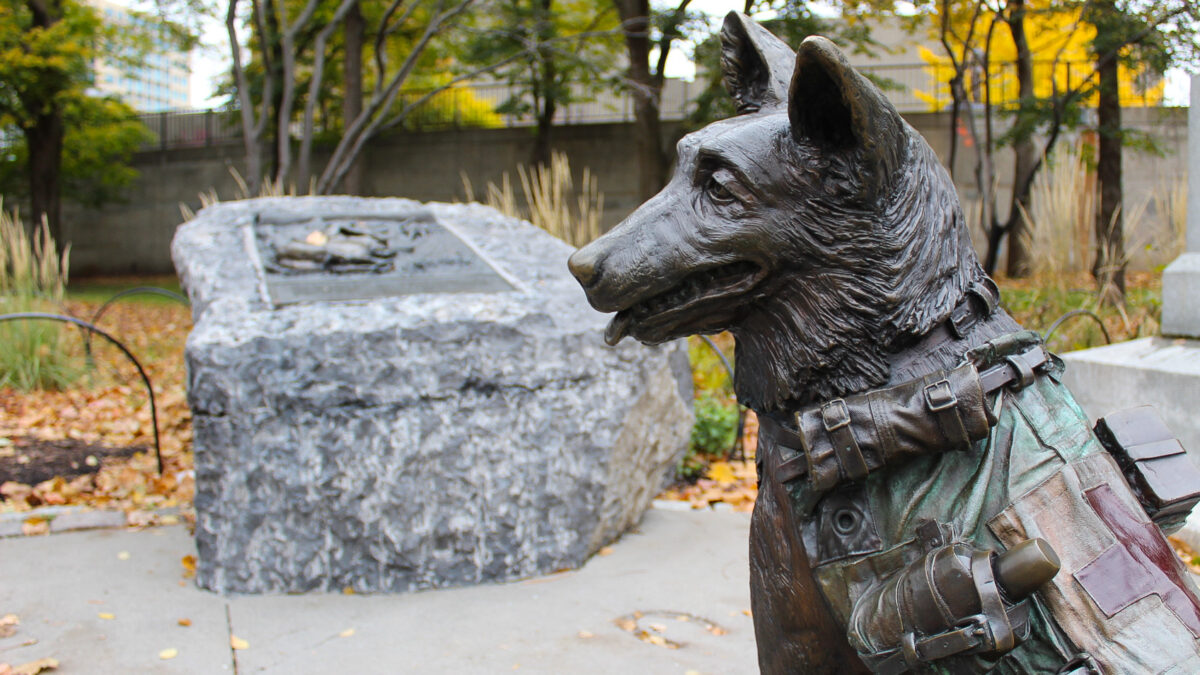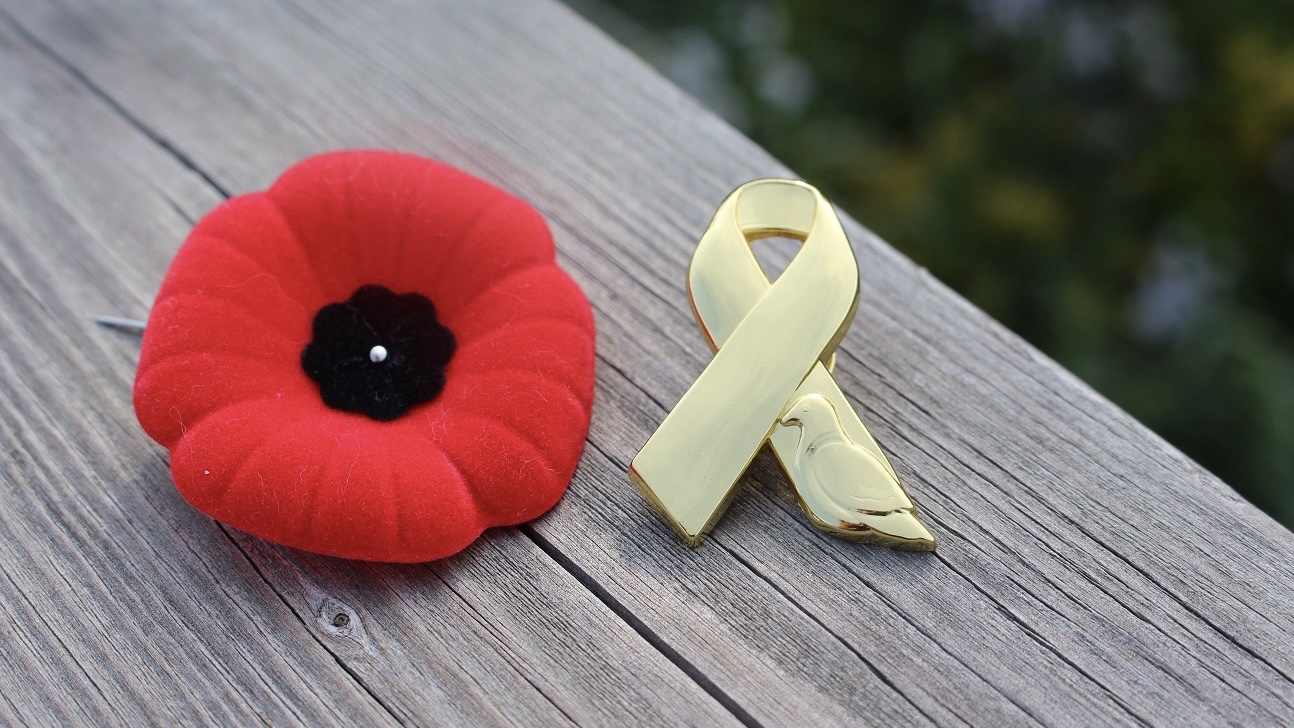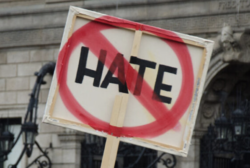As Canadians prepare for this year’s Remembrance Day tributes to the men and women who have served the country in war, Ontario’s SPCA and Humane Society is reminding us that animals, too, played a key role in the First World War and other military conflicts.
The Stouffville, Ont.-based animal advocacy organization has released the latest in a series of pins to commemorate the contributions of animals in wartime ahead of Nov. 11 ceremonies across the province.
“When we think back to all of the incredible sacrifices that animals made during the war, and how much they really meant to the veterans who also served, it just felt natural for us to be able to pay those respects,” said Kallie Milleman, community development specialist with Ontario’s Society for the Prevention of Cruelty to Animals and Humane Society.
The Ontario SPCA and Humane Society, which represents dozens of affiliated animal shelters and veterinary care organizations, originated in 1873 and launched its Animals in War pin campaign in 2017.
As part of the campaign, a new pin is released each year showcasing a different animal’s wartime contribution. Previous animals commemorated include a horse and a dog; this year’s pin features a carrier pigeon.
The pins can be ordered from the society’s website, and cost $12.
“Funds from the sale of the pin help provide care for animals in need, as well as support our veterans,” the society stated in an Oct. 13 announcement about this year’s pigeon pin and the launch of the 2020 “Paws and Give” campaign. “Due to the global pandemic, the Ontario SPCA has increased its commitment to veterans in 2020 by donating $2.50 from each pin sold to Royal Canadian Legion branches across Ontario.”
Carrier pigeons were used in the 1914-18 conflict to transport messages between military outposts, explained Sid Giddings, president of the Georgina Military Museum in Keswick, northeast of Toronto. The birds also played an important role in the Allied bombing missions of the Second World War, he said.
“A lot of bombers would carry pigeons with them so if they went down in the sea and they survived, they would put a message into the pigeon’s message holder on its leg and set it free,” Giddings explained. “They could give an approximate position of where they were in the sea so they could be found. And a lot of people were saved this way.”
While this year’s pin highlights the contributions of pigeons, Millemen says the purpose of the pin is to honour the war contributions of all animals in war, including horses, mules, cats and dogs.
History of animals contributions in war
In the First World War, animals started off as mascots for the regiments, said Giddings. Regiments would adopt animals and bring them overseas when the units were deployed as a morale booster.
“As those animals put their faith into the people that were feeding and looking after them, they also helped those men in the fight for the war,” said Giddings. “A lot of them did some great things just out of loyalty to their masters.”
“A lot of men owe their lives to those horses.”
Sid Giddings, President of the GeorgINA Military Museum, KESWICK, ONT.
One such mascot was the billy goat Sergeant Bill. Bill was adopted by a regiment in Saskatchewan as the soldiers passed through the town of Broadview, Sask. The soldiers smuggled the goat on board with them to England. Bill lived with the soldiers in the trenches and suffered from shrapnel wounds and shell shock.
“His most valiant moment came when the shells were coming over close to them, you could hear them coming, and Bill butted the three men into the trench and saved them,” Giddings said. “The billy goat survived that, as well. So he saved those men and he was very affectionately loved by the men.”
The taxidermied body of Sergeant Bill is currently on display at the Broadview Historical Museum in Saskatchewan.
“A lot of men owe their lives to those horses,” Giddings said.
Animals continued to be a large part of the war effort for the duration of the First World War and throughout the Second World War, said Giddings. Horses were often used to transport troops and haul artillery.
One famous military horse was Warrior, who served with the Canadian cavalry in the First World War. He was awarded the Dickens Medal, the animal equivalent of the Victoria Cross, for his service.
He served in the front lines where he was dubbed “the horse the Germans couldn’t kill.”
Though the use of animals in the military, such as horses and pigeons, declined after the Second World War, dogs are still used in a significant capacity by the military today, according to Giddings. They sniff out mines and explosives and are part of search and rescue missions.
Dogs are at the forefront of animal participation in war because they can be skillfully trained to perform functions, explained Giddings.

Dogs are not the only animals employed by the Canadian military today. According to Animal Alliance Canada, animals such as pigs are most likely still being used for military medical training by the Department of National Defence.
According to the most recent available data from 2012, animals such as pigs were being used for virus and burn studies at Canadian Forces Base Suffield in Alberta, said Liz White, President of Animal Alliance Canada.
The procedures are often painful for the animals, said White. One study she described involved inflicting burn wounds on an animal without pain relief.
Medical testing
Despite the fact that there are more sophisticated approaches to medical testing available, animals are still being used, White said. For example, other NATO countries are using computerized methods for training and experiments to simulate treatment of battlefield wounds.
“Learning on these new approach models that are available, and which are being used by other countries, gives you lots of time to practice. You can do things over and over and over to a patch of simulated skin,” White added.
White has submitted multiple freedom of information requests to access the updated data on military animal use from 2016, but has not received any information, she explained. She added that this makes it difficult to take action on the issue.
“The truth of the matter is that without the information about what they’re actually doing, it’s hard to sort of say to them, ‘We think that you can go into different directions,’ because we don’t actually know exactly what they’re doing from any up-to-date information,” said White.
White said she is hoping to receive the updated information from the Department of National Defence soon so she can write an updated report and press the federal government to consider a computerized approach to training.





Lloyd Swick was my father.
I am thrilled to hear about this pin, as would be he.
Thank you for your story and the mention of my dad.
Patricia Swick